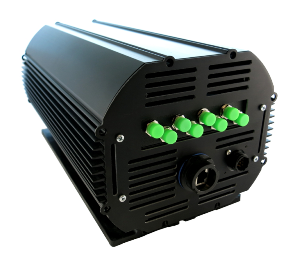Jun 28 2014
The RTS125 is an off-the-shelf, distributed Fiber Optic Sensing solution. With tens of thousands of strain or temperature sensors simultaneously monitored up to 100 times per second, the RTS125 offers the same sensing capabilities on up to eight channels as its predecessor the RTS150 but in a lighter and ruggedized enclosure.
 RTS125 Fiber Optic Sensing solution
RTS125 Fiber Optic Sensing solution
This product delivers reliable measurements in the most demanding environments faced by the aerospace, automotive, civil engineering, and energy sectors among others.
“The groundbreaking distributed sensing capability of the RTS125 is comprehensive because it is possible to measure many different parameters using a single system. This simplifies the collection and monitoring of diverse measurements,” said 4DSP application engineer Alex Tongue. The Fiber Bragg Gratings (FBG) enable the extraction of environmental parameters such as strain loads and temperature gradients continuously along the entire length of the sensor.
With virtually weightless sensor arrays, the RTS125 is applicable to structures of any nature where real-time changes must be monitored with precision. This instrument can be embedded as part of critical applications that require real-time monitoring. For example, it can perform structural monitoring of an aircraft fuselage during flight. The RTS125 can also be used to sense and display the three-dimensional shape of a sensor with a resolution down to 450 micrometers, enabling monitoring of pipelines or mining boreholes in oil & gas applications as well as human arteries in medical applications to accurately determine the shape of complex paths.
“As 4DSP continues to refine our line of fiber optic sensing instruments, the potential for new applications expands,” said 4DSP CTO Pierrick Vulliez. “The RTS125 is a step forward for this revolutionary technology, and its compact size, robust enclosure and increased efficiency make it an appealing choice for demanding installations with stringent limitations on physical space and power consumption.”
Features:
- 8 simultaneously monitored fiber optic sensing channels
- 2048 equally-spaced sensors per fiber
- 0.1 cm to 10 cm spatial resolution
- Real-time strain and temperature measurements through FBG
- Less than 50ms latency
- Up to 100Hz refresh rate
- 3D shape sensing capability
- Resistance to electromagnetic/radio frequency interference and radiation for reliable operation in demanding environments
- Networking capability via Ethernet
Applications:
- Aerospace: Tracking structural shapes and aircraft frames
- Automotive: Studying truck or automobile frames to improve safety or actively control handling
- Structures: Monitoring the overall health of structures that undergo constant stress, such as bridges, dams and buildings
- Wind turbines: Monitoring turbine blade shape and force to improve efficiency and longevity
- Oil & Gas: Determining the shape of pipelines, boreholes, and subsea risers
- Medical: Determining the shape of medical instruments used in non-invasive and minimally invasive surgical procedures
Environmental:
- RCTA-DO-160G (tests pending)
- MIL-STD-810F (tests pending)